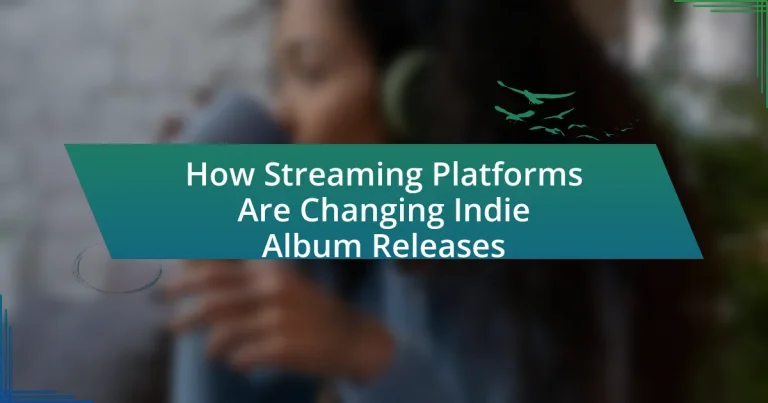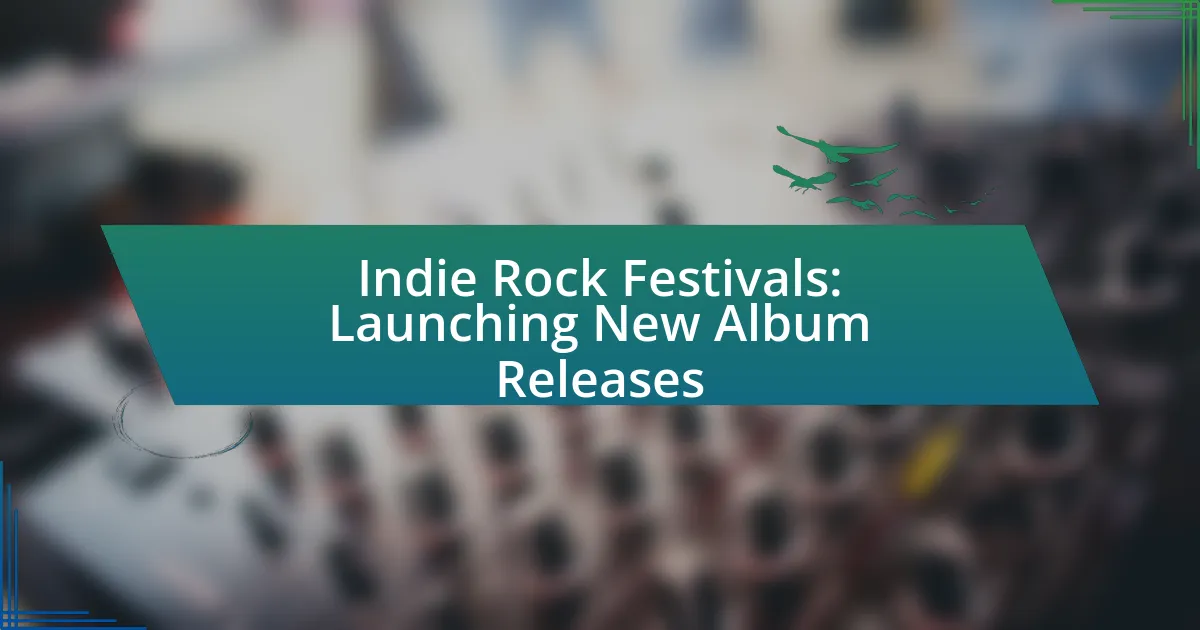Streaming platforms are fundamentally transforming the landscape of indie album releases by providing artists with direct access to global audiences, bypassing traditional record label constraints. This shift has democratized music distribution, allowing indie musicians to release their work independently and gain visibility through platforms like Spotify and Bandcamp. The article explores how streaming services have altered revenue models, influenced album release cycles, and utilized algorithms to promote indie music. It also addresses the challenges indie artists face, such as low streaming revenue and competition for visibility, while highlighting strategies for maximizing success on these platforms. Additionally, the article discusses future trends in music distribution and consumer behavior that may further impact indie album releases.
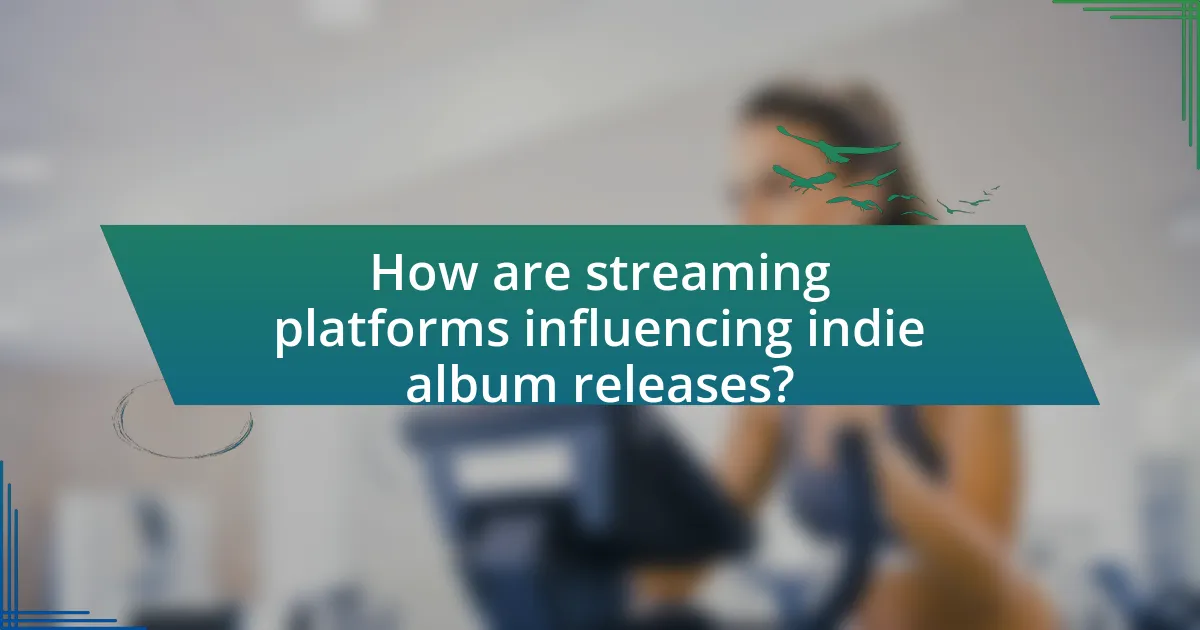
How are streaming platforms influencing indie album releases?
Streaming platforms are significantly influencing indie album releases by providing artists with direct access to global audiences without the need for traditional record labels. This democratization of music distribution allows indie musicians to release their albums independently, leading to increased visibility and potential revenue through streaming royalties. For instance, platforms like Spotify and Bandcamp have enabled indie artists to reach millions of listeners, with Spotify reporting over 60 million tracks available, many from independent creators. Additionally, the data analytics provided by these platforms help artists understand listener preferences, allowing for more targeted marketing strategies and informed release decisions.
What changes have streaming platforms brought to the music industry?
Streaming platforms have revolutionized the music industry by shifting the primary revenue model from physical sales to digital streaming. This transition has led to a significant increase in music accessibility, allowing listeners to access vast libraries of songs for a subscription fee or for free with ads. According to the Recording Industry Association of America (RIAA), streaming accounted for 83% of the total music industry revenue in 2020, highlighting its dominance over traditional sales methods. Additionally, streaming platforms have enabled independent artists to distribute their music globally without the need for traditional record labels, fostering a more diverse music landscape. This democratization of music distribution has empowered indie artists to reach wider audiences, as evidenced by the rise of platforms like Bandcamp and SoundCloud, which prioritize artist control and revenue sharing.
How do streaming platforms alter the traditional album release cycle?
Streaming platforms significantly alter the traditional album release cycle by enabling artists to release singles and EPs more frequently, rather than adhering to the conventional practice of launching full albums every few years. This shift allows musicians to maintain a continuous presence in the market, as evidenced by the rise of artists like Chance the Rapper and Billie Eilish, who have successfully utilized platforms like Spotify and Apple Music to distribute music incrementally. Furthermore, data from the Recording Industry Association of America (RIAA) indicates that streaming has become the dominant form of music consumption, leading to a focus on shorter, more digestible content that caters to listener preferences for immediate access and engagement.
What role do algorithms play in promoting indie albums on streaming platforms?
Algorithms play a crucial role in promoting indie albums on streaming platforms by analyzing user behavior and preferences to recommend music that aligns with individual tastes. These algorithms utilize data such as listening history, genre preferences, and user interactions to curate personalized playlists and suggestions, thereby increasing the visibility of indie albums to potential listeners. For instance, platforms like Spotify and Apple Music employ machine learning techniques to refine their recommendation systems, which can lead to a significant increase in streams for indie artists. According to a 2021 report by the International Federation of the Phonographic Industry, over 60% of users discover new music through algorithm-driven playlists, highlighting the effectiveness of these systems in promoting lesser-known artists.
Why are indie artists turning to streaming platforms for album releases?
Indie artists are turning to streaming platforms for album releases primarily due to increased accessibility and wider audience reach. Streaming platforms like Spotify and Apple Music provide indie musicians with the ability to distribute their music globally without the need for traditional record label support. This democratization of music distribution allows artists to connect directly with listeners, as evidenced by the fact that over 60% of music consumption now occurs through streaming services, according to the Recording Industry Association of America (RIAA). Additionally, these platforms often offer data analytics that help artists understand their audience better, enabling targeted marketing strategies.
What advantages do streaming platforms offer to indie artists compared to traditional methods?
Streaming platforms provide indie artists with greater accessibility and reach compared to traditional methods. These platforms allow artists to distribute their music globally without the need for a record label, significantly reducing barriers to entry. For instance, services like Spotify and Apple Music enable indie artists to upload their tracks directly, reaching millions of listeners instantly. Additionally, streaming platforms offer data analytics that help artists understand their audience demographics and listening habits, which is often unavailable through traditional distribution channels. This data-driven approach empowers indie artists to make informed marketing decisions and tailor their promotional strategies effectively.
How do streaming platforms help indie artists reach wider audiences?
Streaming platforms help indie artists reach wider audiences by providing global access to their music without the need for traditional distribution channels. These platforms, such as Spotify and Apple Music, allow indie artists to upload their tracks directly, making their music available to millions of listeners worldwide. According to a report by the International Federation of the Phonographic Industry (IFPI), over 400 million people use paid streaming services, significantly increasing the potential audience for indie artists. Additionally, algorithms and curated playlists on these platforms promote music based on listener preferences, enabling indie artists to be discovered by users who may not have encountered their work otherwise. This democratization of music distribution has transformed how indie artists connect with fans, leading to increased visibility and opportunities for growth in their careers.
What challenges do indie artists face when using streaming platforms?
Indie artists face significant challenges when using streaming platforms, primarily due to low revenue from streams. For instance, a report by the Music Industry Revenue Report in 2021 indicated that artists earn an average of $0.003 to $0.005 per stream, making it difficult for indie musicians to sustain their careers financially. Additionally, the oversaturation of content on these platforms complicates visibility, as millions of tracks compete for listener attention, leading to challenges in audience engagement and discovery. Furthermore, indie artists often lack the marketing resources that major labels provide, which can hinder their promotional efforts on these platforms.
How does competition on streaming platforms affect indie album visibility?
Competition on streaming platforms significantly reduces indie album visibility. With major artists dominating playlists and algorithmic recommendations, indie albums struggle to gain traction. For instance, a report by MIDiA Research indicates that independent artists receive only about 16% of total streaming revenue, highlighting the disparity in exposure compared to mainstream artists. Additionally, the sheer volume of content uploaded daily—over 60,000 tracks—means that indie albums often get lost in the noise, making it challenging for them to reach potential listeners.
What are the financial implications of releasing albums on streaming platforms for indie artists?
Releasing albums on streaming platforms has significant financial implications for indie artists, primarily characterized by lower per-stream revenue compared to traditional sales. Indie artists typically earn between $0.003 and $0.005 per stream, which means substantial streaming numbers are required to generate meaningful income. For instance, an artist would need approximately 250,000 streams to earn $1,000, highlighting the challenge of monetization through streaming alone. Additionally, while streaming platforms provide broader exposure and access to global audiences, they often require artists to share revenue with the platform and distributors, further reducing their earnings. This financial model can lead to reliance on live performances and merchandise sales for sustainable income, as streaming revenue alone may not cover production and marketing costs associated with album releases.
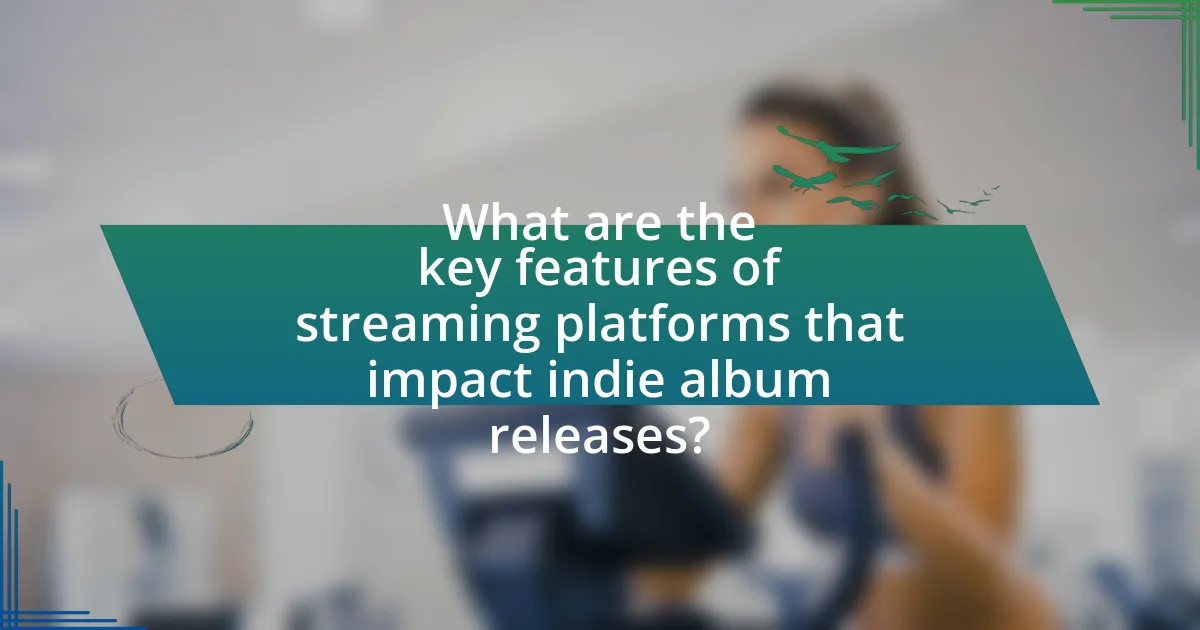
What are the key features of streaming platforms that impact indie album releases?
The key features of streaming platforms that impact indie album releases include accessibility, algorithm-driven recommendations, and data analytics. Accessibility allows indie artists to reach a global audience without the need for traditional distribution channels, significantly increasing their visibility. Algorithm-driven recommendations enhance discoverability by promoting indie albums to users based on listening habits, which can lead to increased streams and fan engagement. Data analytics provide artists with insights into listener demographics and preferences, enabling them to tailor their marketing strategies effectively. These features collectively empower indie artists to navigate the music industry more efficiently and connect with their audience directly.
How do playlists influence the success of indie albums on streaming platforms?
Playlists significantly enhance the success of indie albums on streaming platforms by increasing visibility and listener engagement. When an indie album is featured on popular playlists, it can reach a broader audience, leading to higher streaming numbers and potential sales. For instance, a study by the Music Business Association found that tracks included in curated playlists can experience a 30% increase in streams compared to those not featured. This exposure not only boosts immediate listenership but also contributes to long-term fan growth, as listeners often explore more of the artist’s work after discovering them through playlists.
What strategies can indie artists use to get featured on popular playlists?
Indie artists can use targeted outreach, social media engagement, and playlist submission platforms to get featured on popular playlists. Targeted outreach involves identifying and contacting playlist curators directly, providing them with a personalized pitch that highlights the artist’s unique sound and relevance to the playlist’s theme. Social media engagement allows artists to build relationships with fans and curators, increasing their visibility and chances of being noticed. Additionally, using playlist submission platforms like SubmitHub or PlaylistPush can streamline the process of getting music in front of curators, as these platforms connect artists with a wide range of playlists. According to a 2021 study by MIDiA Research, playlists are a primary discovery tool for 75% of music listeners, emphasizing the importance of these strategies for indie artists seeking exposure.
How do user-generated playlists affect indie album discovery?
User-generated playlists significantly enhance indie album discovery by curating diverse music selections that reach wider audiences. These playlists often feature lesser-known artists alongside popular tracks, increasing visibility for indie albums that may not receive mainstream promotion. According to a study by the University of Southern California, playlists created by users on platforms like Spotify and Apple Music account for over 30% of all streams, demonstrating their influence on listener behavior and album exploration. This exposure allows indie artists to connect with potential fans who might not have discovered their music through traditional channels, ultimately driving album sales and streaming numbers.
What role does data analytics play in indie album releases on streaming platforms?
Data analytics plays a crucial role in indie album releases on streaming platforms by providing insights into listener behavior and preferences. This data enables independent artists to tailor their marketing strategies, optimize release timing, and enhance audience engagement. For instance, analytics can reveal which songs are most popular among specific demographics, allowing artists to focus promotional efforts on those tracks. Additionally, platforms like Spotify and Apple Music offer artists access to detailed metrics, such as stream counts and listener locations, which can inform decisions about touring and merchandise. According to a 2021 report by MIDiA Research, 70% of independent artists utilize data analytics to inform their release strategies, demonstrating its significance in the modern music landscape.
How can indie artists leverage streaming data to improve their marketing strategies?
Indie artists can leverage streaming data by analyzing listener demographics, engagement metrics, and geographic trends to tailor their marketing strategies effectively. By utilizing platforms like Spotify for Artists or Apple Music for Artists, musicians can access detailed analytics that reveal which songs resonate most with specific audiences, allowing them to focus promotional efforts on high-performing tracks. For instance, if data shows a significant number of streams from a particular city, artists can target that location with localized marketing campaigns, such as social media ads or live performances. Additionally, understanding listener behavior, such as peak streaming times and playlist placements, enables artists to optimize release schedules and promotional activities, ultimately enhancing audience engagement and driving sales.
What insights can artists gain from listener demographics on streaming platforms?
Artists can gain valuable insights from listener demographics on streaming platforms, including age, gender, location, and listening habits. Understanding these demographics allows artists to tailor their marketing strategies, select appropriate tour locations, and create content that resonates with their audience. For instance, data from Spotify indicates that artists can identify which age groups are most engaged with their music, enabling them to focus promotional efforts on platforms popular among those demographics. Additionally, knowing the geographic distribution of listeners can inform decisions on where to perform live shows, maximizing attendance and engagement. This targeted approach is supported by analytics tools provided by streaming services, which offer detailed reports on listener behavior and preferences.
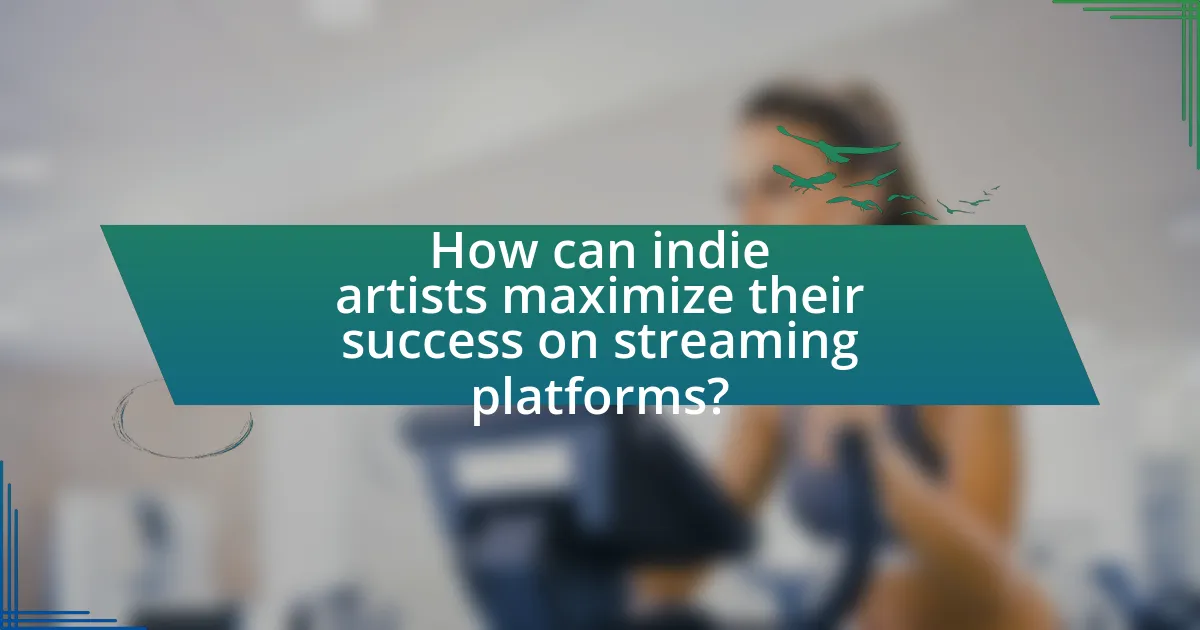
How can indie artists maximize their success on streaming platforms?
Indie artists can maximize their success on streaming platforms by leveraging data analytics, engaging with their audience, and utilizing playlist placements. Data analytics allows artists to understand listener demographics and preferences, enabling targeted marketing strategies. Engaging with their audience through social media and live performances fosters a loyal fan base, which can drive streaming numbers. Additionally, securing placements on popular playlists can significantly increase visibility; for instance, tracks featured on Spotify’s “Discover Weekly” can see a surge in streams, with some artists reporting increases of over 300% in monthly listeners after such placements.
What best practices should indie artists follow when releasing albums on streaming platforms?
Indie artists should focus on strategic planning, marketing, and audience engagement when releasing albums on streaming platforms. First, they should establish a release schedule that allows for adequate promotion, ideally several weeks in advance, to build anticipation. Utilizing social media and email newsletters can effectively reach their audience and create buzz around the release.
Next, artists should consider pre-saving campaigns, which encourage fans to save the album before its release, boosting initial streaming numbers. Collaborating with influencers or playlists can also enhance visibility, as playlists significantly impact streaming success; for instance, being featured on a popular playlist can lead to thousands of new listeners.
Additionally, artists should optimize their profiles on streaming platforms by ensuring high-quality artwork, accurate metadata, and engaging bios, as these elements contribute to a professional appearance and can attract more listeners. Finally, analyzing streaming data post-release helps artists understand their audience better and refine future marketing strategies.
How important is timing for releasing an album on streaming platforms?
Timing is crucial for releasing an album on streaming platforms, as it significantly influences visibility and listener engagement. Research indicates that albums released on Fridays, the industry-standard release day, tend to achieve higher chart positions and streaming numbers due to the alignment with consumer behavior and promotional strategies. For instance, a study by the International Federation of the Phonographic Industry (IFPI) found that 70% of music consumption occurs on weekends, making Friday releases optimal for maximizing initial streams and audience reach. Additionally, aligning releases with cultural events or trends can further enhance an album’s impact, as seen with artists who strategically time their releases around major holidays or music festivals to capitalize on heightened listener interest.
What promotional tactics can enhance an indie album’s performance on streaming platforms?
Utilizing social media marketing, playlist placements, and collaborations can significantly enhance an indie album’s performance on streaming platforms. Social media marketing allows artists to engage directly with their audience, creating buzz and anticipation around album releases. For instance, platforms like Instagram and TikTok have proven effective for indie artists, with TikTok’s algorithm enabling viral trends that can lead to increased streams.
Playlist placements on popular streaming services, such as Spotify and Apple Music, can also drive substantial traffic to an album. According to a study by Spotify, tracks featured on curated playlists can see a 30% increase in streams. Collaborating with other artists or influencers can further amplify reach, as it exposes the album to new audiences.
These tactics are supported by data indicating that indie artists who actively engage in these promotional strategies often experience higher visibility and engagement on streaming platforms, leading to improved performance metrics.
What common pitfalls should indie artists avoid when using streaming platforms?
Indie artists should avoid the common pitfall of neglecting marketing strategies when using streaming platforms. Many indie musicians assume that simply uploading their music will lead to success, but without effective promotion, their work may go unnoticed. According to a study by the Music Industry Research Association, 70% of independent artists reported that lack of visibility on streaming platforms significantly hindered their ability to gain traction. Additionally, failing to engage with listeners through social media and live performances can limit their audience growth. Therefore, proactive marketing and audience engagement are essential for indie artists to maximize their presence on streaming platforms.
How can indie artists ensure they are not overshadowed by mainstream releases?
Indie artists can ensure they are not overshadowed by mainstream releases by strategically timing their album launches and leveraging niche marketing. By releasing music during periods with fewer major mainstream releases, indie artists can capture more attention from listeners. For instance, data from Billboard indicates that independent artists often find success by avoiding weekends when major albums drop, as this can significantly impact visibility on streaming platforms. Additionally, utilizing targeted social media campaigns and engaging directly with their fanbase can create a loyal following that prioritizes their music over mainstream options. This approach is supported by the fact that indie artists who actively engage with their audience on platforms like Instagram and TikTok see higher engagement rates, which can lead to increased streams and visibility.
What mistakes do indie artists often make in their streaming strategies?
Indie artists often make the mistake of neglecting data analytics in their streaming strategies. By failing to analyze listener demographics, engagement metrics, and streaming patterns, artists miss opportunities to tailor their marketing efforts effectively. For instance, a study by MIDiA Research indicates that understanding audience behavior can increase engagement by up to 30%, highlighting the importance of data-driven decisions in optimizing streaming performance. Additionally, many indie artists overlook the significance of playlist placements, which can dramatically enhance visibility; according to Spotify, tracks featured on popular playlists can see a 300% increase in streams.
What are the future trends for indie album releases on streaming platforms?
Future trends for indie album releases on streaming platforms include increased reliance on data analytics for targeted marketing and personalized listener experiences. As streaming services like Spotify and Apple Music continue to evolve, indie artists will leverage these platforms’ algorithms to reach niche audiences more effectively. Additionally, the rise of direct-to-fan sales models will empower indie musicians to retain a larger share of revenue, as platforms like Bandcamp facilitate direct transactions. According to a 2022 report by MIDiA Research, indie artists are projected to see a 30% increase in revenue from streaming by 2025, driven by these trends.
How might emerging technologies impact indie music distribution in the future?
Emerging technologies will significantly enhance indie music distribution by enabling more direct artist-to-fan connections and streamlining the distribution process. Innovations such as blockchain technology can provide transparent royalty tracking, ensuring that artists receive fair compensation for their work. Additionally, advancements in artificial intelligence can facilitate personalized music recommendations, increasing visibility for indie artists on streaming platforms. According to a report by MIDiA Research, the global music streaming market is projected to grow to $76 billion by 2027, indicating a rising opportunity for indie musicians to reach wider audiences through these platforms.
What shifts in consumer behavior could affect indie album releases on streaming platforms?
Shifts in consumer behavior that could affect indie album releases on streaming platforms include increased preference for curated playlists and a growing demand for personalized music experiences. As listeners increasingly rely on algorithms and playlists for music discovery, indie artists may struggle to gain visibility unless they are featured in popular playlists. Additionally, the rise of social media platforms, where trends can rapidly change, influences consumer engagement with music, making it essential for indie artists to adapt their marketing strategies to capture fleeting audience attention. According to a 2022 report by the International Federation of the Phonographic Industry, 70% of consumers discover new music through streaming playlists, highlighting the critical role of curation in shaping listener behavior and its potential impact on indie album success.
